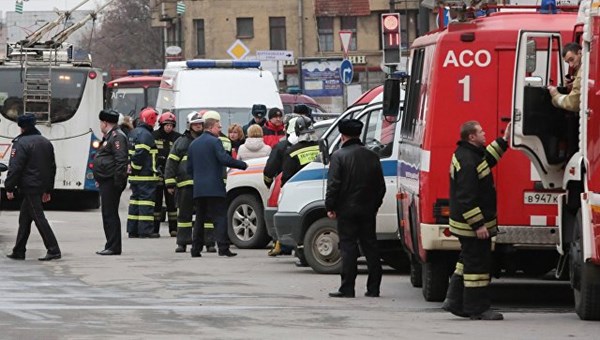Act of terror in Russia, initial information points to radical Islamists
On April 3 there was an explosion in a Saint Petersburg metro. The device went off while the train was traveling the stretch between the Sennaya Ploshchad and Tekhnologichesky Institut metro stations. According to official information, 10 people were killed and 47 injured. However, the local media talks about 14 casualties. The authorities have not yet confirmed this information.
The investigative committee announced that criminal proceedings were being initiated according to article 205 of the Russian Criminal Code – a terrorist act. Three days of mourning have been declared on account of the act of terror.
The supposed perpetrator of the explosion in the carriage of the St Petersburg metro was caught on surveillance cameras. Citing its own source, Interfax reported that the explosive device was located in a briefcase in the carriage. Later, the local media published a screenshot from the exterior surveillance cameras, showing the person who presumably committed the terrorist act. The image shows a tall, bearded man in black clothes. Law enforcement officials consider it possible that the man dressed in this way in order to mislead the investigation, REN TV reported. There is also information that the terrorist act was organized by a suicide bomber. The identification of the supposed perpetrator of the explosion is underway, and the local media writes that he could come from the Caucasus.
Later, at 15:00, it became clear that law enforcement officials had found an unexploded home-made explosive device. Specialists disabled it and no one was harmed, Interfax reported, citing a source in the National Anti-Terrorism Committee. The management of the Federal Security Service (FSB) of the northern capital announced that the bomb was loaded with shrapnel and disguised as a fire extinguisher. The home-made explosive device’s power came from approximately one kilogram of TNT.
Police are searching for two persons suspected of planning the terrorist act.
“One who placed the explosive device in the carriage. The other who left the bomb at Ploshchad Vosstaniya station,” Interfax writes, citing a source in the law enforcement organizations.
On the same day, April 3, Russian President Vladimir Putin was in St Petersburg. He met with Belarusian President Alexander Lukashenko, and also with local reporters. The terrorist act did not interfere with Putin’s schedule.
“The municipal authorities, and if required, the federal too, will take all the necessary measures to show support to the families of the victims and our injured citizens,” the president said at the start of the meeting with the Belarusian leader, Alexander Lukashenko. According to Putin, he had already received reports from the heads of the intelligence services.
Later the newspaper Kommersant reported with reference to a “reliable source” that the Russian intelligence services were aware that a terrorist act in Saint Petersburg was being planned.
The note did not mention exactly what the intelligence services were aware of; the only thing that is specified is that “their information was far from complete”.
According to the publication’s information, a Russian who had returned to Russia from Syria and had been arrested informed the intelligence services about the terrorist act being planned. The newspaper writes that he had collaborated with terrorists from the “Islamic State” and “he knew several members of a sabotage group sent to Russia”.
As is evident from the article, the intelligence services learned several phone numbers from this person, although no significant results were attained by monitoring them, since the SIM cards were not registered to “real people”, and during discussions the conspirators did not mention “names, times or meeting places”.
After the explosion, the publication writes, the intelligence services blocked these numbers, “disrupting underground communication at once”.
Citing a source in the law enforcement organizations, the Russian news agency Interfax reported that according to provisional information, the explosion in the Saint Petersburg metro which took place on April 3 was carried out by a terrorist suicide bomber whose identity has already been established.
“According to one of the theories, the explosive device at the St Petersburg metro was detonated by a suicide bomber. According to provisional information, it was a 23 year old native of Central Asia,” the news agency’s source said.
According to him, the man in dark clothes who was caught on camera and was suspected earlier of involvement in the explosion has appeared before the police and claimed his innocence.
According to the source’s information, the supposed suicide bomber who triggered the explosion in the Saint Petersburg metro was associated with radical Islamist groups. The terrorist supposedly brought the explosive device into the Saint Petersburg underground in a rucksack.
“The remains recovered on site support the theory that the explosion was caused by a suicide bomber, although the final conclusion could be made after DNA examination,” the source said.
The news agency also reported that the home-made bomb at the St Petersburg metro station Ploshchad Vosstaniya was left by the same person who caused the explosion in the carriage between the Sennaya Ploshchad and Tekhnologichesky Institut stations.
The world has already reacted to the events. World leaders have posted their condolences on their social network pages. US President Donald Trump commented briefly on the act of terror at the Saint Petersburg metro, calling it a “terrible thing”.
The news outlet Vocativ says that “ISIS supporters are praising an explosion on a St. Petersburg subway train”. They call it revenge for the Russian government’s support of Syrian President Bashar al-Assad.
